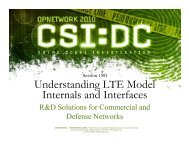Automated Axon Tracking of 3D Confocal Laser Scanning ...
Automated Axon Tracking of 3D Confocal Laser Scanning ...
Automated Axon Tracking of 3D Confocal Laser Scanning ...
Create successful ePaper yourself
Turn your PDF publications into a flip-book with our unique Google optimized e-Paper software.
found by skeletonization process. The authors <strong>of</strong> (Streekstra et al., 2002) used derivatives <strong>of</strong> aGaussian kernel to find the direction and the location <strong>of</strong> the centerlines. The orientation <strong>of</strong> thecenterline is first found by computing the direction along which the second order derivative isthe least in magnitude. In a plane perpendicular to this direction, a point where the gradientvanishes is declared to be the center. Though the algorithms that fall in this category aretheoretically attractive, their computational costs increase significantly with the size andcomplexity <strong>of</strong> the datasets.Commercially or publicly available s<strong>of</strong>tware packages, such as NeuronJ (Meijering et al.,2004) and Reconstruct (Fiala, 2005), on the other hand, track the centerlines in such fluorescentmicroscopic stacks interactively. NeuronJ, a plug-in for the freely available s<strong>of</strong>tware, ImageJ(Abram<strong>of</strong>f et al., 2004), uses live-wire (Barrett et al., 1997) method to track the centerlines in theMIP image. The user has to select at least two points for each axon and has to guide thecenterline when there is an ambiguity. Reconstruct also needs user intervention when the axonsare close to each other. Manually segmenting huge stacks <strong>of</strong> data is a painstaking task and canlead to fatigue related bias.A new and computationally efficient tracking algorithm for extracting the centerlines <strong>of</strong> theaxons in fluorescent microscopy datasets is presented in this paper. We introduce a robust hybridalgorithm to track the centerlines <strong>of</strong> the axons in three-dimensional space with minimal userintervention. The basic approach is to track well-separated axons in the MIP plane using a lowcomplexitytwo-dimensional approach developed in (Can et al., 1999) and adopt morecomputationally sophisticated algorithms when the centerlines appear to intersect each other inthe MIP image. In addition, we make use <strong>of</strong> the cross-sectional information as the cross-over <strong>of</strong>centerlines can be easily resolved using this approach. Our approach can be summarized as: (1)5















